Uncategorised
+ more newsNutrients: status of observations
Thursday, 10 August 2023
Nutrients
Tuesday, 08 August 2023
|
Nutrients have been amongst major observational variables in various international global ocean observation expeditions, such as the Geochemical Ocean Sections Study (GEOSECS) in the 1970s, the World Ocean Circulation Experiment (WOCE) in the 1990s, and the on-going Climate Variability and Predictability (CLIVAR). Observation of the natural variability of nutrients in the world’s oceans, and investigation of temporal and spatial changes due to the oceans’ response to climate change and increasing carbon dioxide in the atmosphere, continue to be important topics of oceanographic research. Therefore, the comparability and traceability of nutrient data in the world’s oceans are fundamental issues in marine science, particularly for studies of global climate change.
Since 1965 numerous inter-laboratory comparison studies that have been carried out to improve comparability of nutrients data in the world oceans (UNESCO, 1965, 1967; ICES 1967, 1977; Kirkwood, 1991, Aminot et al., 1995; Topping, 1997; Willie and Clancy, 2000; Clancy and Willie, 2003; Aoyama et al., 2006, 2008, 2010, 2013). However, no globally approved consensus has been achieved to date. The 4th IPCC Assessment Report in 2007 highlighted this problem inherent in comparing existing data sets: "Uncertainties in deep ocean nutrient observations may be responsible for the lack of coherence in the nutrient changes. Sources of inaccuracy include the limited number of observations and the lack of compatibility between measurements from different laboratories at different times” (Bindoff et al., 2007).
To guarantee comparability of data from different laboratories and from different research cruises, globally accepted research methods (RMs) and certified reference materials (CRMs) for nutrients' measurements are being developed and IOCCP plays an active role in these efforts. International collaboration and action is now required to harmonize oceanic nutrient data using globally accepted RMs/CRMs. Particularly important issues for the study of changes in properties of deep water masses is to develop a system by which the data within laboratories and between laboratories is comparable at the 0.1 % level. This should be both within individual cruises and extend to allowing comparison between cruises separated by decades. The IOCCP in strong collaboration with institutional and programmatic partners worldwide is going to work towards the development of such system to harmonize global oceanic nutrients analysis.
|
Responsible SSG Member
NUTRIENTS EOV
|
Integrated Marine Debris Observing System (IMDOS)
Wednesday, 22 March 2023
|
A JOINT PROJECT OF:
The goal of the Integrated Marine Debris Observing System (IMDOS) is to provide guidance and coordination of a global sustained observing system for marine debris addressing knowledge gaps and diverse stakeholder needs with adequate data and information. Why do we need an IMDOS?There is a strong, shared demand for global marine litter/marine debris monitoring expressed by a diverse group of stakeholders forming the Global Partnership for Marine Litter (GPML). Monitoring of marine litter has already been initiated to various degrees through Action Plans of the Regional Seas Programme, and there are ongoing efforts to harmonise and standardise monitoring methods regionally and globally, supported by UNEP, IOC-UNESCO, G7 and G20 initiatives, among others. However, there is insufficient coverage, saturation and quality of data to meet the science and policy requirements expressed by SDG Target 14.1.1b, and other indicators recommended for global scale monitoring, also included under the new Marine Plastics Debris Essential Ocean Variable.
Availability and transfer of data into science-based decision making is partly hindered by challenges in extracting quality information from collected data (e.g., beach litter), and limited integration and interoperability of existing data sources. Moreover, there is currently no international scientific advisory body with a mandate to undertake regular evaluation of the state of marine debris in the oceans as well as variations and trends as a basis for scientific advice to policy makers.
A coordinated and collaborative global response to these challenges will be fundamental in providing the adequate technical and scientific support for all players engaged in implementing the now negotiated UN treaty on plastic pollution and it will offer a significant contribution to the UN Decade of Ocean Science for Sustainable Development.
|
Coordination
Artur Palacz (IOPAN, Poland)
Audrey Hasson (Mercator Ocean International/ GEO Blue Planet, France)
Mine B. Tekman (Mercator Ocean International/GEO Blue Planet consultant, Turkey) This email address is being protected from spambots. You need JavaScript enabled to view it.
Communication:
Dominik Krzymiński (IOCCP/IOPAN, Poland) This email address is being protected from spambots. You need JavaScript enabled to view it.
|
The IMDOS ambition
Inspired by the collective vision of the marine debris scientific community and guided by an international Interim Steering Committee, IMDOS aims to:
- promote the development of a global network of marine debris observations according to Regional Seas Programme Action Plans and integrated within GOOS in cooperation with existing ocean observing infrastructures, networks and communities of practice;
- define strategies and priorities for coordinated and harmonised marine debris observations based on most relevant monitoring methods, standards and practices;
- promote integration of data management activities to provide free and open access to marine debris data and information products for stakeholders (e.g., via the GPML Digital Platform);
- support the development of remote sensing methods to detect marine debris by enhancing availability of required ground-truthing data;
- strengthen the interface between marine debris monitoring and modelling communities to support the development of a Digital Twin of the Ocean for Marine Litter Pollution;
- evaluate the readiness level and promote technological innovation to advance global observing approaches;
- develop standard sampling protocols and best practices in marine litter data collection and support training activities for their implementation;
- create communication services for the marine debris community including links to advocacy resources and other components of the multidisciplinary global ocean observing system.
Building IMDOS as a collective impact organisation
Designed according to the principles of collective impact organisations, IMDOS will serve as backbone support for many international and national organisations and initiatives that: (i) share a vision for coordinated marine debris observations to address the complex issue of marine pollution, (ii) collect data and report results consistently, (iii) contribute with differentiated yet mutually reinforcing activities, (iv) engage in consistent and open communication, and (v) have a backbone coordinating structure.
IMDOS is being developed as a joint project by the Global Ocean Observing System (GOOS) and the Group on Earth Observations (GEO) Blue Planet Initiative, in collaboration with the United Nations Environment Programme (UNEP) Global Partnership on Marine Litter (GPML), the Scientific Committee on Oceanic Research (SCOR) Working Group #153, GESAMP Working Group #40, the International Ocean Colour Coordinating Group Task Force on Remote Sensing of Marine Litter and Debris, Ministry of Environment Japan (MOEJ), among others.
Currently, short-term part-time coordination support for IMDOS is provided by GOOS and GEO Blue Planet with funding from the European Union facilitated through the EU4OceanObs and H2020 EuroSea projects. A dedicated, globally distributed staff of at least 3 full-time employees is needed on the long run to provide overall coordination and communication of IMDOS operations and execution of Terms of Reference according to the Strategy and Implementation Plan, which are being developed under the guidance of an Interim Steering Committee.
Interim IMDOS Steering Committee
- Stefano Aliani (CNR ISMAR, Italy)
- Paolo Corradi (ESA, the Netherlands)
- Francois Galgani (Ifremer, France)
- Georg Hanke (JRC, Italy)
- Kara Lavender Law (SEA, USA)
- Nikolai Maximenko (Uni. Hawaii, USA)
- Toste Tanhua (GEOMAR, Germany)
- Alexander Turra (Uni. Sao Paolo, Brazil)
Instruments and Sensors Directory - test
Wednesday, 17 March 2021
Ocean Acidification: resources
Thursday, 18 February 2021
Following is a list of selected resources of potential use to the ocean acidification community. Many resources can be found through the GOA-ON website, also linked here below.
 |
2019 IOCCP & BONUS INTEGRAL Sensors Training Course: Video lecture recordings and lectures in PDF on a number of topics related to ocean acidification observations available from the Ocean Teacher Global Academy Website HERE |
|
|
|
|
Reference Materials |
For inquires related to purchasing Certified Reference Materials for oceanic CO2 measurements please contact Andrew Dickson's group at: This email address is being protected from spambots. You need JavaScript enabled to view it.. Below you can find some information on batches of CRMs produced so far, and 3 references describing the Reference Material program.
|
|
|
SDG 14.3.1 Indicator methodology, data and metadata templates |
|
CO2 System Calculation Tools |
Comparison of 10 packages that compute ocean carbonate chemistry, all listed below:
Uncertainty propagation add-ons - Orr et al. (2018) |
Particulate Matter - IOCCP Activities
Tuesday, 09 February 2021
We are developing an initial set of activities and we will indicate their progress here.
Relevant white paper from OceanObs'09 Conference
Monday, 07 September 2020
- Adornato, L. & Co-Authors (2010). "In Situ Nutrient Sensors for Ocean Observing Systems" in Proceedings of OceanObs'09: Sustained Ocean Observations and Information for Society (Vol. 2), Venice, Italy, 21-25 September 2009, Hall, J., Harrison, D.E. & Stammer, D., Eds., ESA Publication WPP-306, doi:10.5270/OceanObs09.cwp.01
 PDF
PDF
- Borges, A. & Co-Authors (2010). "A Global Sea Surface Carbon Observing System: Inorganic and Organic Carbon Dynamics in Coastal Oceans" in Proceedings of OceanObs'09: Sustained Ocean Observations and Information for Society (Vol. 2), Venice, Italy, 21-25 September 2009, Hall, J., Harrison, D.E. & Stammer, D., Eds., ESA Publication WPP-306, doi:10.5270/OceanObs09.cwp.07
 PDF
PDF
- Byrne, R. & Co-Authors (2010). "Sensors and Systems for In Situ Observations of Marine Carbon Dioxide System Variables" inProceedings of OceanObs'09: Sustained Ocean Observations and Information for Society (Vol. 2), Venice, Italy, 21-25 September 2009, Hall, J., Harrison, D.E. & Stammer, D., Eds., ESA Publication WPP-306, doi:10.5270/OceanObs09.cwp.13
 PDF
PDF
- Claustre, H. & Co-Authors (2010). "Bio-Optical Profiling Floats as New Observational Tools for Biogeochemical and Ecosystem Studies: Potential Synergies with Ocean Color Remote Sensing." in Proceedings of OceanObs'09: Sustained Ocean Observations and Information for Society (Vol. 2), Venice, Italy, 21-25 September 2009, Hall, J., Harrison, D.E. & Stammer, D., Eds., ESA Publication WPP-306, doi:10.5270/OceanObs09.cwp.17
 PDF
PDF
- Fairall, C. & Co-Authors (2010). "Observations to Quantify Air-Sea Fluxes and their Role in Climate Variability and Predictability" in Proceedings of OceanObs'09: Sustained Ocean Observations and Information for Society (Vol. 2), Venice, Italy, 21-25 September 2009, Hall, J., Harrison, D.E. & Stammer, D., Eds., ESA Publication WPP-306, doi:10.5270/OceanObs09.cwp.27
 PDF
PDF
- Feely, R. & Co-Authors (2010). "An International Observational Network for Ocean Acidification" in Proceedings of OceanObs'09: Sustained Ocean Observations and Information for Society (Vol. 2), Venice, Italy, 21-25 September 2009, Hall, J., Harrison, D.E. & Stammer, D., Eds., ESA Publication WPP-306, doi:10.5270/OceanObs09.cwp.29
 PDF
PDF
- Garzoli, S. & Co-Authors (2010). "Progressing Towards Global Sustained Deep Ocean Observations" in Proceedings of OceanObs'09: Sustained Ocean Observations and Information for Society (Vol. 2), Venice, Italy, 21-25 September 2009, Hall, J., Harrison, D.E. & Stammer, D., Eds., ESA Publication WPP-306, doi:10.5270/OceanObs09.cwp.34
 PDF
PDF
- Goni, G. & Co-Authors (2010). "The Ship of Opportunity Program" in Proceedings of OceanObs'09: Sustained Ocean Observations and Information for Society (Vol. 2), Venice, Italy, 21-25 September 2009, Hall, J., Harrison, D.E. & Stammer, D., Eds., ESA Publication WPP-306, doi:10.5270/OceanObs09.cwp.35
 PDF
PDF
- Gruber, N. & Co-Authors (2010). "Adding Oxygen to Argo: Developing a Global In Situ Observatory for Ocean Deoxygenation and Biogeochemistry" in Proceedings of OceanObs'09: Sustained Ocean Observations and Information for Society (Vol. 2),Venice, Italy, 21-25 September 2009, Hall, J., Harrison, D.E. & Stammer, D., Eds., ESA Publication WPP-306, doi:10.5270/OceanObs09.cwp.39
 PDF
PDF
- Hood, M. & Co-Authors (2010). "Ship-Based Repeat Hydrography: A Strategy for a Sustained Global Program" in Proceedings of OceanObs'09: Sustained Ocean Observations and Information for Society (Vol. 2), Venice, Italy, 21-25 September 2009, Hall, J., Harrison, D.E. & Stammer, D., Eds., ESA Publication WPP-306, doi:10.5270/OceanObs09.cwp.44
 PDF
PDF
- Hydes, D. & Co-Authors (2010). "The Way Forward in Developing and Integrating Ferrybox Technologies" in Proceedings of OceanObs'09: Sustained Ocean Observations and Information for Society (Vol. 2), Venice, Italy, 21-25 September 2009, Hall, J., Harrison, D.E. & Stammer, D., Eds., ESA Publication WPP-306, doi:10.5270/OceanObs09.cwp.46
 PDF
PDF
- Monteiro, P. & Co-Authors (2010). "A Global Sea Surface Carbon Observing System: Assessment of Changing Sea Surface CO2 and Air-Sea CO2 Fluxes" in Proceedings of OceanObs'09: Sustained Ocean Observations and Information for Society (Vol. 2), Venice, Italy, 21-25 September 2009, Hall, J., Harrison, D.E. & Stammer, D., Eds., ESA Publication WPP-306, doi:10.5270/OceanObs09.cwp.64
 PDF
PDF
- Send, U. & Co-Authors (2010). "OceanSITES" in Proceedings of OceanObs'09: Sustained Ocean Observations and Information for Society (Vol. 2), Venice, Italy, 21-25 September 2009, Hall, J., Harrison, D.E. & Stammer, D., Eds., ESA Publication WPP-306, doi:10.5270/OceanObs09.cwp.79
 PDF
PDF
- Smith, S. & Co-Authors (2010). "Automated Underway Oceanic and Atmospheric Measurements from Ships" in Proceedings of OceanObs'09: Sustained Ocean Observations and Information for Society (Vol. 2), Venice, Italy, 21-25 September 2009, Hall, J., Harrison, D.E. & Stammer, D., Eds., ESA Publication WPP-306, doi:10.5270/OceanObs09.cwp.82
 PDF
PDF
- Testor, P. & Co-Authors (2010). "Gliders as a Component of Future Observing Systems" in Proceedings of OceanObs'09: Sustained Ocean Observations and Information for Society (Vol. 2), Venice, Italy, 21-25 September 2009, Hall, J., Harrison, D.E. & Stammer, D., Eds., ESA Publication WPP-306, doi:10.5270/OceanObs09.cwp.89
 PDF
PDF
- Belbeoch, M. & Co-Authors (2010). "The JCOMM In Situ Observing Platform Support Centre: A Decade of Progress and Remaining Challenges" in Proceedings of OceanObs'09: Sustained Ocean Observations and Information for Society (Vol. 2), Venice, Italy, 21-25 September 2009, Hall, J., Harrison, D.E. & Stammer, D., Eds., ESA Publication WPP-306, doi:10.5270/OceanObs09.cwp.04
 PDF
PDF
Synthesis Activities
Friday, 26 July 2019
|
IOCCP is committed to promoting and developing interoperable data management activities and policies to ensure open access to, and preservation of, fully documented ocean carbon and biogeochemistry data. A key activity is to promote the integration of ocean carbon and biogeochemistry information into research and assessments including the use of relevant data synthesis products. For more than a decade, IOCCP has continued to support the development of two global data synthesis projects, both constituting a tremendous community effort: Surface Ocean CO2 Atlas (SOCAT; www.socat.info) and the Global Ocean Data Analysis Project (GLODAP; www.glodap.info). These successful efforts have resulted in two mature products with regular updates providing a key source of information on the global distribution and trends in biogeochemical EOVs in the surface ocean and the ocean interior, respectively. Both SOCAT and GLODAP have been used for a number of applications, including climate modelling and assessments. Please follow the links below to learn more about SOCAT and GLODAP, to access the newest product releases, and to submit your data.
IOCCP continues to support new ideas for future synthesis products related to for example dissolved oxygen measurements from multiple observing platforms, or for various applications requiring data from a global network of time series stations.
|
Responsible SSG Member |
|
|
 |
|
|
GLOBAL OCEAN DATA ANALYSIS PROJECT
|
SURFACE OCEAN CO2 ATLAS
|
SOCATv2025 released on 5 June 2025
SOCAT version 2025 has quality-controlled in situ surface ocean fCO2 (fugacity of CO2) measurements made on ships, moorings, autonomous and drifting surface platforms for the global ocean and coastal seas from 1957 to 2024. The latest update of the community-led Surface Ocean CO2 Atlas (www.socat.info), version 2025, contains 41.4 million, quality-controlled, in situ surface ocean fCO2 measurements with an estimated uncertainty of better than 5 μatm collected between 1957 and 2024, which constitute the main SOCAT synthesis and gridded products (Fig. 1b, 2a, 2b).
We want to thank all >100 data contributors, quality controllers and other contributors who made SOCAT version 2025 possible, and acknowledge the continued leadership of Dorothee Bakker (UEA, UK) in producing the annual SOCAT release.
Click here to download the SOCAT version 2025 release poster 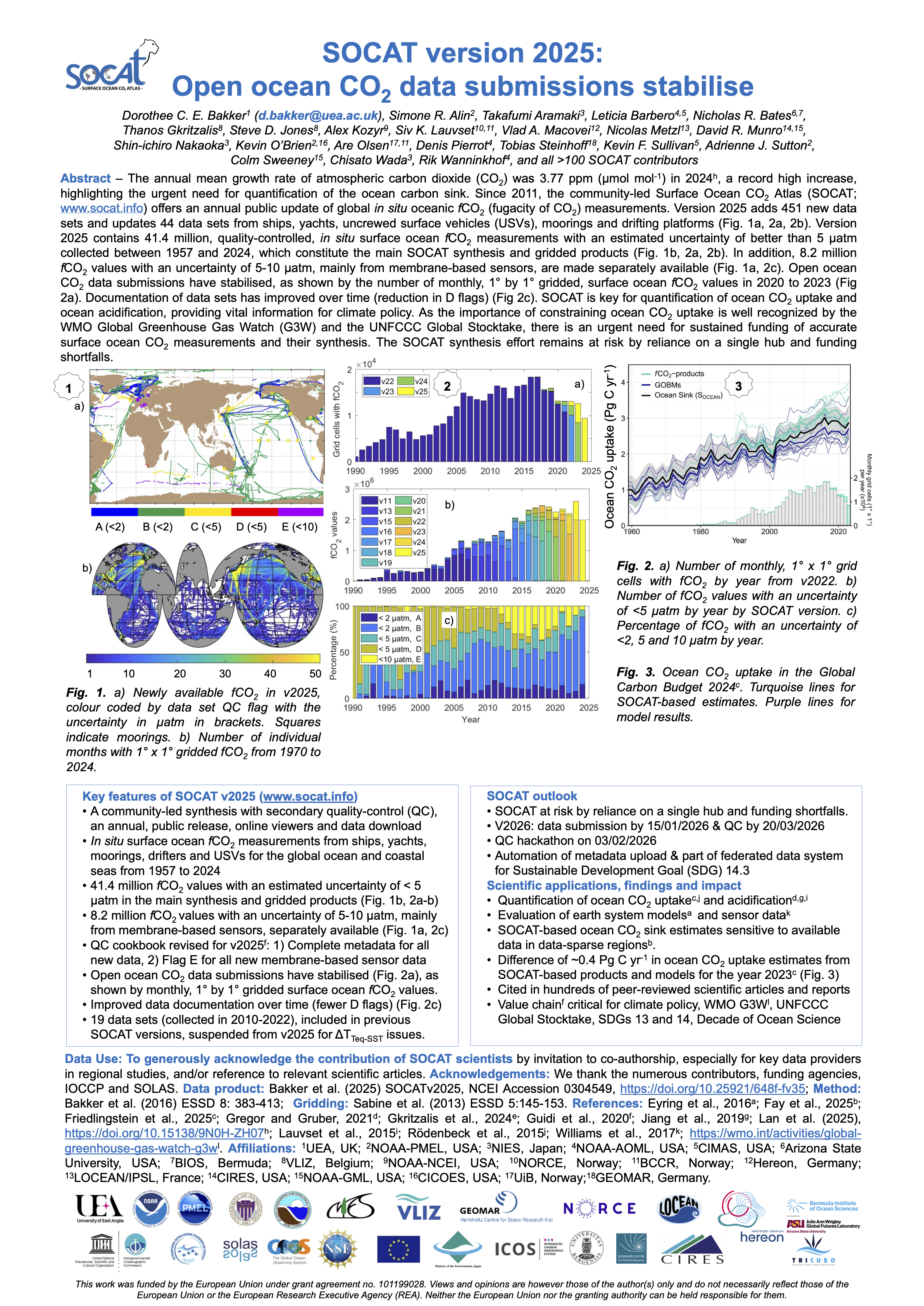
GLODAPv2.2023 released in October 2023
The Global Ocean Data Analysis Project (GLODAP) data product provides access to quality controlled surface to bottom ocean biogeochemical data, with an emphasis on seawater inorganic carbon. GLODAPv2.2023 is an update of the previous version, with 23 additional cruises and includes measurements from more than 1.4 million water samples from the global oceans collected on 1108 cruises. The data for the 13 core variables have undergone extensive quality control, especially systematic evaluation of bias. The data are available in two formats: (i) as submitted by the data originator but updated to WOCE exchange format and (ii) as a merged data product with adjustments applied to minimize bias.
The original data, their documentation and doi codes are available at the Ocean Carbon Data System of NOAA NCEI. This site also provides access to the merged data product, which is provided as a single global file and as four regional ones, and access to the GLODAPv2.2023 ODV collection.
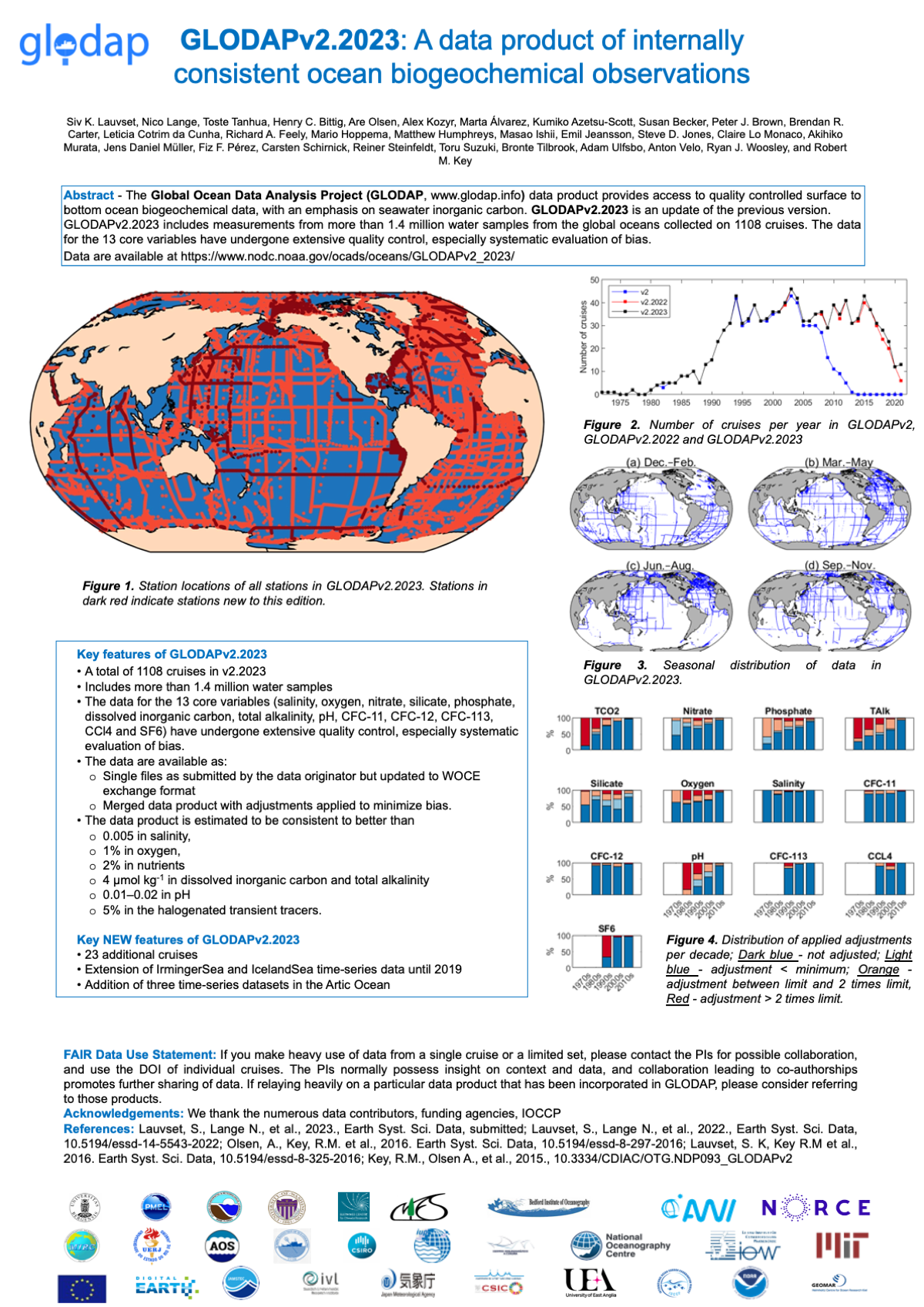
GLODAP: Background and history
Synthesis of ocean interior carbon and carbon-relevant data has been supported by IOCCP since the beginning of the project. Such data are of fundamental importance for accurate assessments of oceanic carbon inventories and uptake rates and for model validation. Over time, three efforts were initiated: GLODAP(v1.1), CARINA and PACIFICA.
All follow rigorous and ever-improving data quality control (QC) procedures to assure the highest possible internal data quality and consistency with other efforts. Key members of the international marine CO2 community over the past 4 years were assembling the new global carbon data product, Global Ocean Data Analysis v2 (GLODAPv2). This product assembles all past carbon and carbon-relevant data products covering interior ocean into one harmonized data package. Specifically the data from the previously assembled products CARINA, GLODAP v1.1 and PACIFICA. Additionally data from almost two hundred ”new” cruises were added to this collection. IOCCP continues to support this challenging effort.
GLOBAL OCEAN DATA ANALYSIS PROJECT
The GLobal Ocean Data Analysis Project (GLODAP) is a cooperative effort to coordinate global synthesis projects funded through the U.S. National Oceanic and Atmospheric Administration (NOAA), the U.S. Department of Energy (DOE), and the National Science Foundation (NSF) as part of the Joint Global Ocean Flux Study - Synthesis and Modeling Project (JGOFS-SMP). Cruises conducted as part of the World Ocean Circulation Experiment (WOCE), JGOFS, and the NOAA Ocean-Atmosphere Exchange Study (OACES) over the decade of the 1990s have created an oceanographic database of unparalleled quality and quantity. These data provide an important asset to the scientific community investigating carbon cycling in the oceans. The central objective of this project is to generate a unified data set to help determine the global distributions of both natural and anthropogenic inorganic carbon, including radiocarbon. These estimates provide an important benchmark against which future observational studies will be compared. They also provide tools for the direct evaluation of numerical ocean carbon models.
ATLANTIC OCEAN CARBON SYNTHESIS GROUP
This project was initiated at the IOCCP-CarboOcean Initial Atlantic Ocean Carbon Synthesis Meeting, June 28-30 2006, Laugarvatn, Iceland. The meeting brought together 23 participants from 9 countries with expertise ranging from ship-based hydrography and carbon measurements, physical oceanography, surface pCO2 variability, CFC and tracer measurements, O2 on profiling floats, modeling, and data synthesis and management. During the meeting it was decided that the CARINA (Carbon in the Atlantic) data synthesis should be extended to include the Arctic and Southern Oceans. The Workshop participants developed three coordinated synthesis groups and a common data module:
- North Atlantic working group (lead: Are Olsen, Bjerknes Center for Climate Research, Bergen, Norway)
- Atlantic working group (lead: Toste Tanhua, IFM-GEOMAR, Kiel, Germany)
- South Atlantic / Southern Ocean (lead: Mario Hoppema, AWI, Bremerhaven, Germany)
- Data: Robert Key, Princeton University, USA
These groups met three times after the Iceland meeting; in Kiel, Germany (March 2007), Delmenhorst, Germany (December 2007) and Paris, France (June 2008) to tune the methodology and evaluate the results. Further more, an interactive website was developed that allowed the different investigators to upload and view results of the synthesis. By the end of 2008, the CARINA secondary quality control was finalized. After this the individual cruise data in WOCE exchange format, as well as three merged data products, were published on CDIAC (CARINA at CDIAC) and on CCHDO (CARINA at CCHDO). Working documents, and updates on follow-up activities are also available from the CDIAC website. In addition to these data, an ODV collection and Matlab routines to facilitate reading the data was added to the CIDAC site. The documentation of the CARINA project is primarily done through 20 articles published in a special issue in Earth System Science Data.
NORTH PACIFIC CARBON SYNTHESIS GROUP
This synthesis activity was launched with a workshop entitled “Understanding North Pacific Carbon-Cycle Changes: A Data Synthesis and Modeling Workshop”, held in Seattle in June 2004. This workshop was sponsored by NOAA's Global Carbon Cycle Program with additional support from the North Pacific Marine Science Organization (PICES), The Global Carbon Project (GCP), and the University of Washington Program on Climate Changes (UWPCC). This workshop addressed 3 primary questions:
- 1. How are air-sea CO2 fluxes in the North Pacific affected by different modes of variability?
- 2. How and why are the North Pacific distribution patterns of carbon, nutrients and oxygen in the water column changing with time?
- 3. What are the requirements for detecting a climate change signal in the North Pacific carbon cycle?
A special section of the Journal of Geophysical Research entitled “North Pacific Carbon Cycle Variability and Climate Change” was published in 2006 (C. Sabine and N. Gruber, guest editors, Introduction doi:10.1029/2006JC003532). In 2005 this international collaboration was further formalized with the formation of the PICES Section on Carbon and Climate. A major data synthesis effort subsequently got underway. This project was known as PACIFICA and was coordinated by M. Ishii (Japan) and R. Key (United States). This project has adopted many of the methodologies developed by CARINA in the Atlantic and was expected to be completed in early 2013.
SOCAT: Background and history
Net CO2 absorption by the world’s oceans is known to benefit human-kind by reducing the concentration of this greenhouse gas in the atmosphere, but the increase in ocean carbon also causes ocean acidification endangering marine organisms. Knowledge of year-to-year and decadal changes in oceanic CO2 uptake are essential for assessing the feedbacks between climate change and the ocean carbon cycle.
In 2007 the international ocean carbon community led by the IOCCP, SOLAS and IMBER initiated the Surface Ocean CO2 Atlas (SOCAT) project to ensure long-term access to high quality, regularly updated surface ocean CO2 data. First public release of SOCAT dataset took place on 14 September 2011 providing unrestricted access to 6.3 million surface water fCO2 (fugacity of carbon dioxide) measurements taken on 1851 cruises from 1968 to 2007.
Both the raw input data and the recalculated output data are publicly available and the methods used are fully documented on the SOCAT website. The unique aspect of this dataset is that the observations have been combined into a single uniform format and were quality controlled. To make the dataset user-friendly, it is available on the web through a sophisticated online data visualisation and manipulation tool called the Live Access Server. The LAS provides interactive maps that enable users to interrogate the data. Gridded monthly data are also available. Potential applications include carbon budgets, studies of seasonal, year-to-year and decadal variation in oceanic CO2 uptake, and research into the processes driving these. For a complete list of SOCAT impacts see here.
Regular updates to SOCAT are planned. The IOCCP continues to strongly support SOCAT efforts to further improve and streamline data submission, quality control and access procedures. The latest version of SOCAT is available from www.socat.info.
Surface CO2 Observations - Exciting developments
Monday, 04 March 2019
|
|
US OCB Working Group - Filling the gaps in observation-based estimates of air–sea carbon fluxes working group
Principle Investigators: Galen McKinley, Jessica Cross, Tim DeVries, Peter Landschützer, Goulven G. Laruelle, Nicole Lovenduski, Pedro Monteiro, Ray Najjar, Laure Resplandy, Adrienne Sutton, Rik Wanninkhof, and Nancy Williams
1st Meeting: May 5-6, 2020 at Lamont-Doherty Earth Observatory
Summary: A number of recent studies have applied novel statistical and machine-learning methods to in situ surface ocean carbon dioxide (CO2) observations to estimate the ocean carbon sink with unprecedented spatio-temporal resolution. These studies suggest that the oceanic CO2 sink is more variable on multiyear timescales than previously estimated from biogeochemical model simulations. This newly identified variability challenges our model-based mechanistic understanding and puts into question our projections of the future ocean carbon sink. These observation-based estimates, however, rely on extensive interpolation of limited observations, and thus their reliability is unclear, particularly in data-sparse regions and seasons. Furthermore, inconsistencies regarding the area covered by open and coastal ocean estimates hampers our ability to constrain CO2 fluxes across the full marine continuum (i.e., all tidal waters). The goal of this working group will be to assess critical uncertainties in existing observation-based products, determine how best to integrate observation-based open-ocean and coastal-ocean CO2 air–sea fluxes, and quantify uncertainties in the natural (pre-industrial) outgassing of CO2. These efforts will lead to better constraints on the contemporary ocean carbon sink and its variability. The results of this OCB Working Group will assist the global carbon community in understanding the state of the global carbon cycle so as to contribute to international efforts to address climate change.
For more information on the planned activities and expected impacts please see the full WG proposal.
Status of Surface CO2 Observations
Thursday, 28 February 2019
|
|
Surface ocean pCO2 measurements are conducted on research vessels and ships of opportunity, as well as on moorings and surface gliders. This page shows the approximate status of the global network of these observations.
Ships of Opportunity / Volunteer Observing Ships
The map below illustrates the global network of Ships of Opportunity / Volunteer Observing Ships that collect underway pCO2 measurements. Currently, there are ships from 14 nations around the globe contributing to this component of the ocean observing system.
Last modified: November 2018
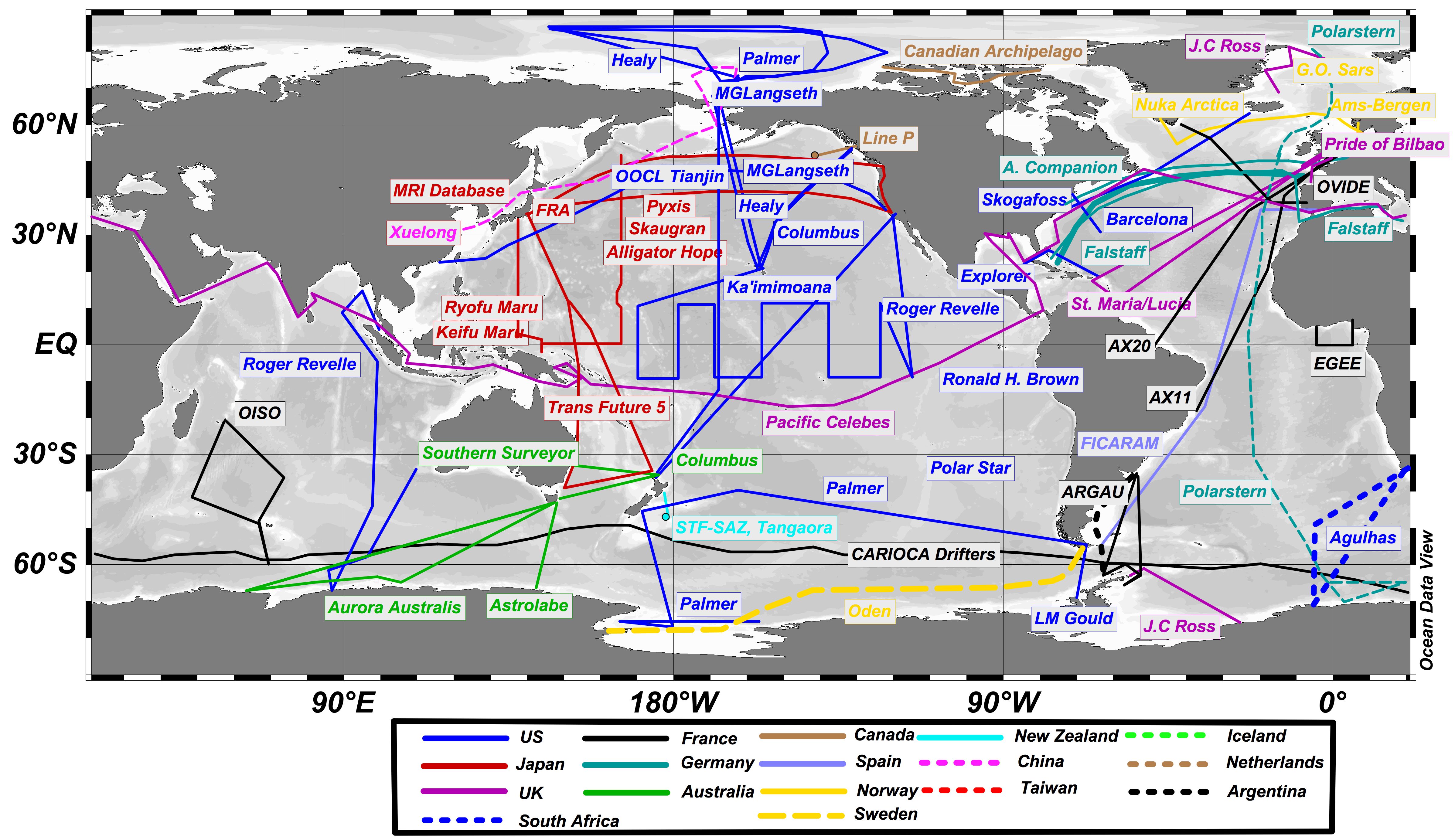
For more information on individual cruises and data, click on the section names using the interactive version of the map on the OCADS-NCEI site here: https://www.nodc.noaa.gov/ocads/oceans/VOS_Program/
Moorings
Below is a map of moorings with pCO2 measurements performed in open ocean (blue), coastal (green) and coral reef (red) settings. Interactive version of the map is available from NOAA PMEL Carbon Program at https://www.pmel.noaa.gov/co2/story/CO2+Data+Discovery
Last modified: February 2019
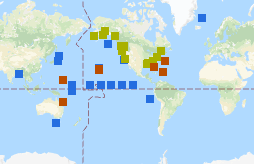
Integrated Carbon Observation System - Ocean Thematic Centre (ICOS OTC)
ICOS OTC maintains an array of ocean stations and cruise tracks along which underway CO2 observations are made. ICOS OTC is the European node of SOCONET. See the map below for the current status of the observing network.
The IOCCP promotes the development of a global network of ocean carbon observations for research through technical coordination and communication services, international agreements on standards and methods, and advocacy and links to the global observing systems. The IOCCP is co-sponsored by the Scientific Committee on Oceanic Research and the Intergovernmental Oceanographic Commission of UNESCO. Read more…
Calendar
|
|
IOCCP meetings, IOCCP-related meetings as well as events related to a wider scope in marine biogeochemistry. |



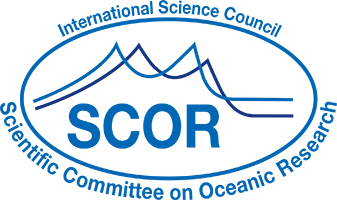


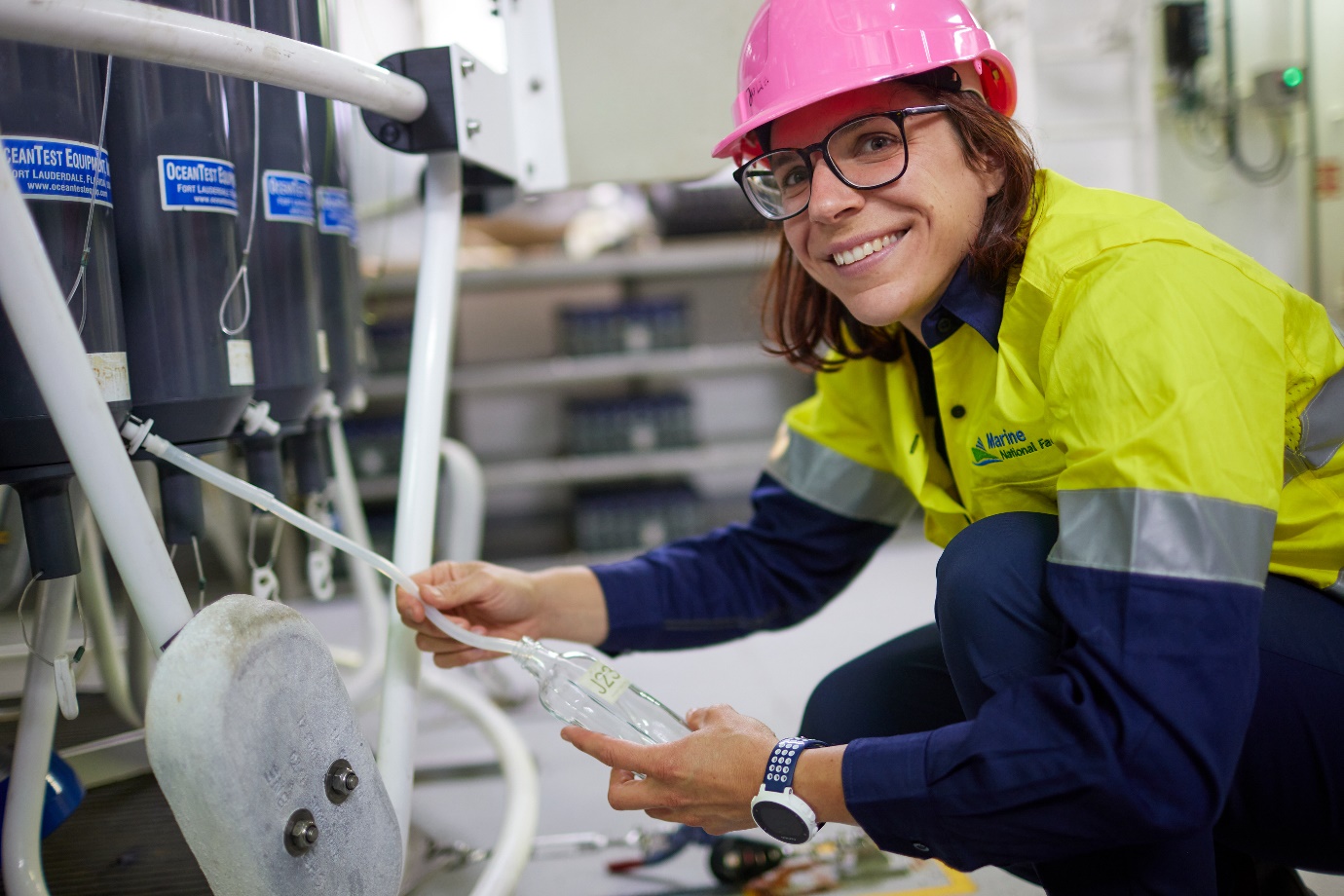

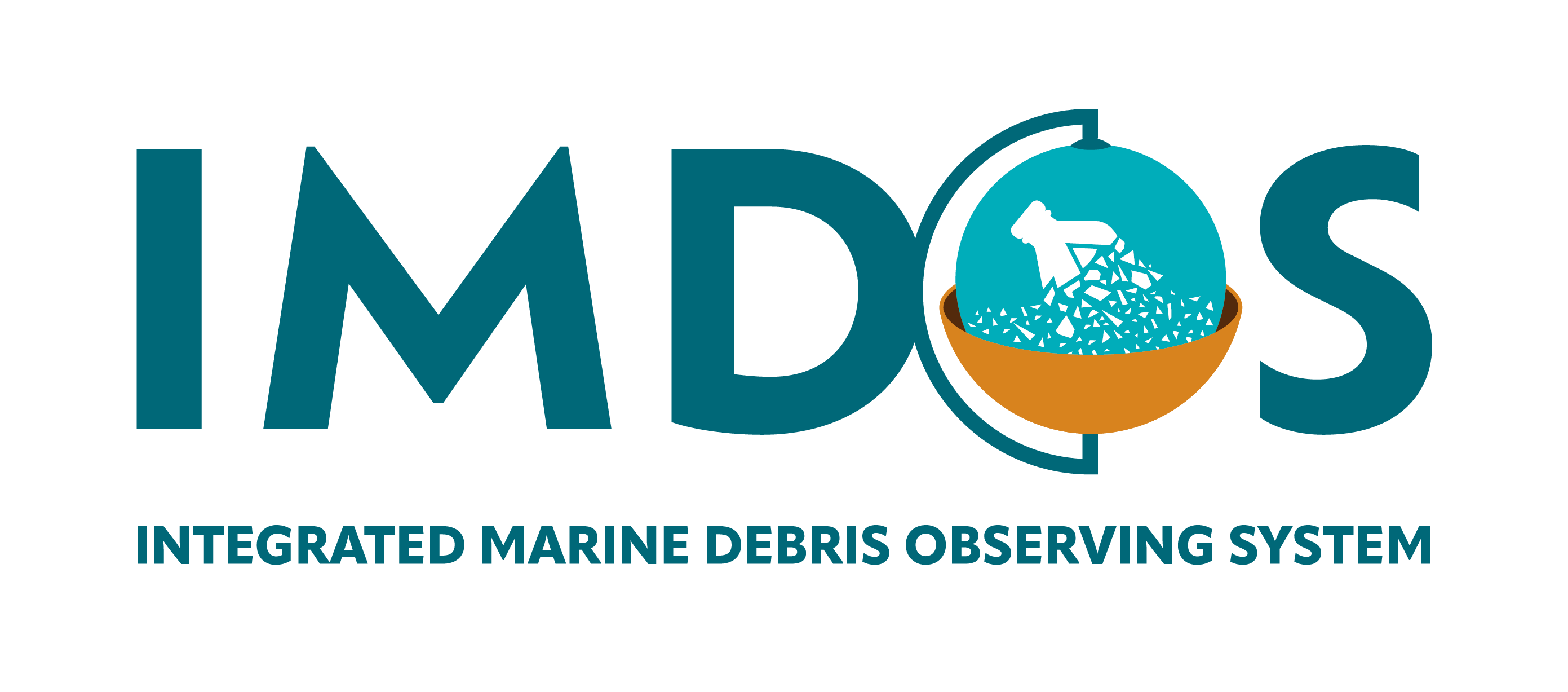

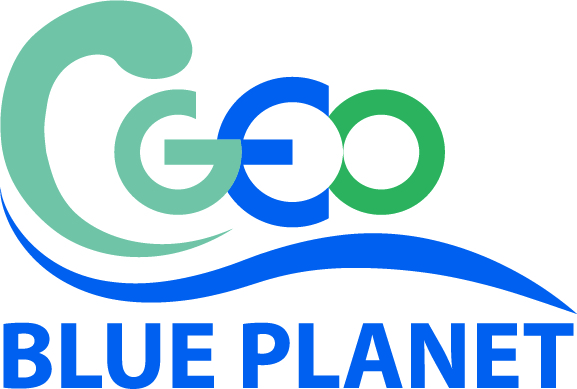
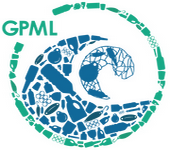
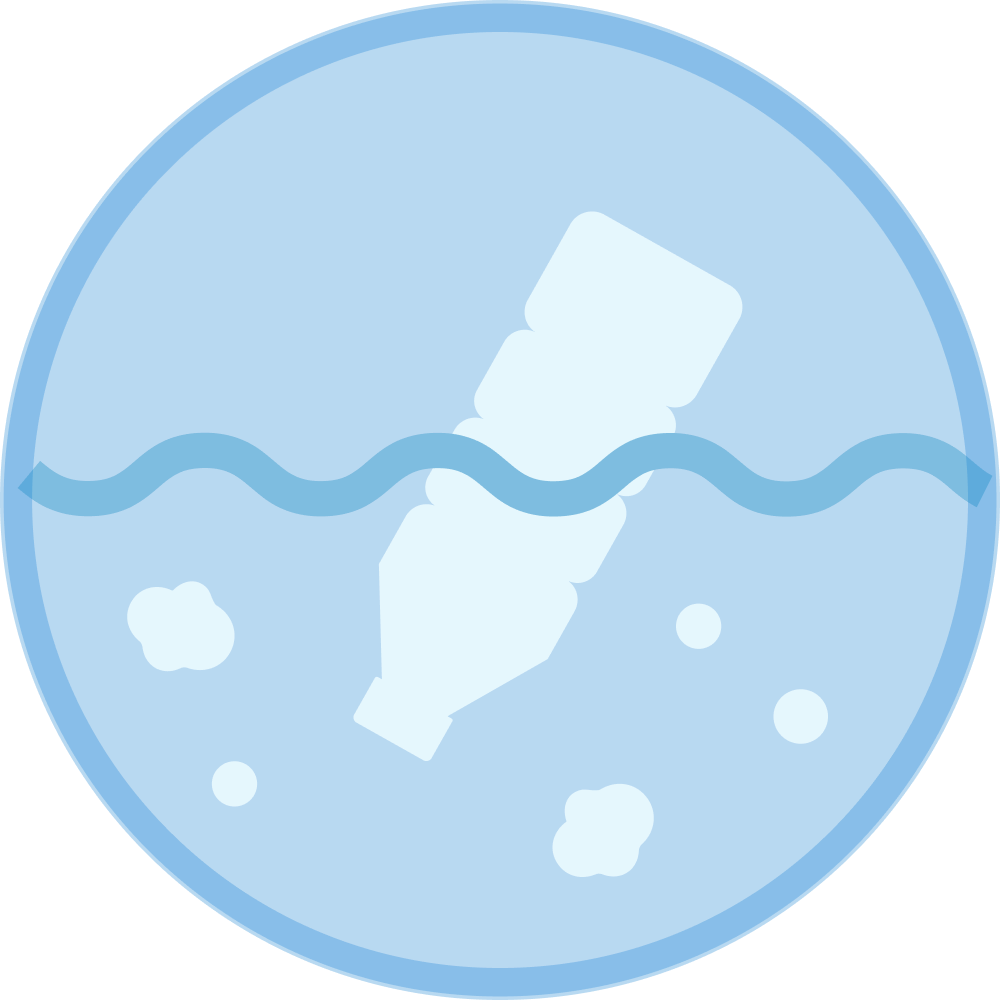


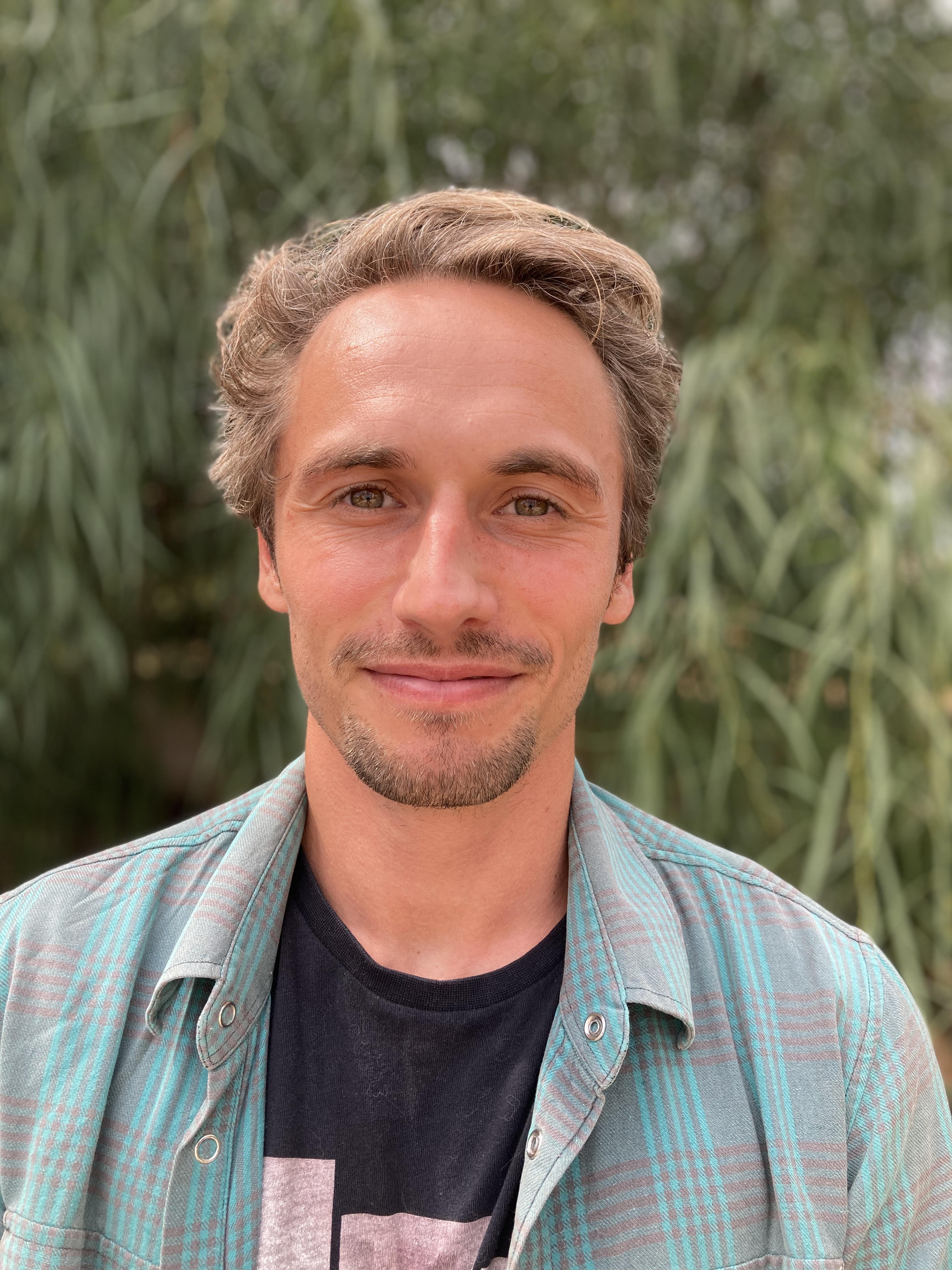

 Please wait...
Please wait...